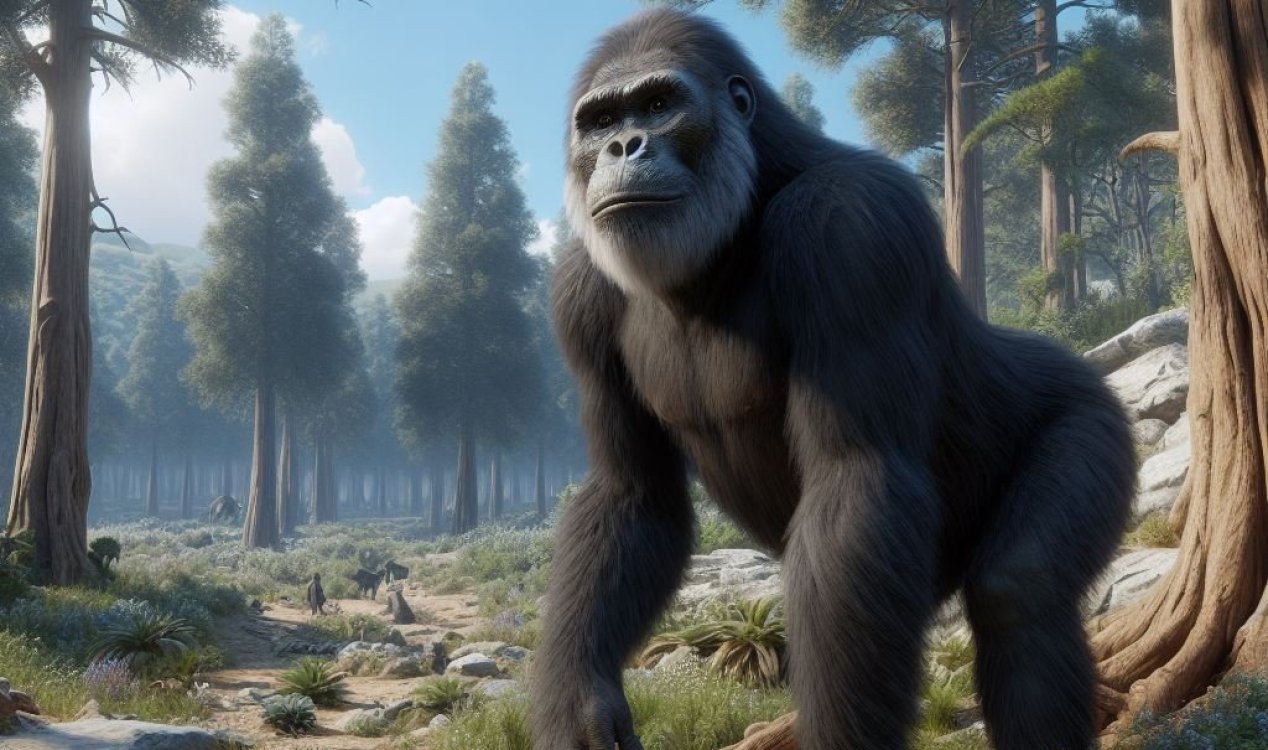Palaeontology
January 11, 2024 · 10 comments
10 comments

Giant apes were once very much the real deal. Image Credit: Bing AI / Dall-E 3
For millions of years, this enormous ape roamed what is today modern-day China, but then something happened around 600,000 years ago that eventually caused it to go extinct.
What's interesting is that we actually know very little about Gigantopithecus save for what can be ascertained from a few fossilized teeth and jawbone fragments.
We don't even know what it looked like and no complete skeleton has ever been found.
Determining exactly what wiped the species out, therefore, has long proven a challenge.
Now in a renewed effort to solve this mystery, scientists including Associate Professor Kira Westaway of Macquarie University ventured to China's Guangxi Province to explore 22 separate caves from which they collected samples of pollen, fossils and sediment.
By analyzing these samples, they were able to build up a picture of the region's environmental history.
It turns out that around 2.3 million years ago, the region was covered in dense forests that would have been the perfect habitat for Gigantopithecus.
Around 600,000 years ago, however, things began to change.
"The more seasonal climate created dry periods when fruits were difficult to find," Westaway told IFL Science. "G. blacki relied on a less nutritious fall back food such as bark and twigs whereas [orangutans were] more flexible in [their] fall back food, eating shoots, leaves, flowers, nuts, seeds, and even insects and small mammals."
Unable to adapt or roam very far due to its immense size, Gigantopithecus gradually dwindled in number while orangutans adapted to take advantage of these new opportunities.
Sadly, by around 215,000 years ago, these prehistoric giants had disappeared entirely.
Source: IFL Science | Comments (10)
Real-life 10ft prehistoric 'King Kong' disappeared 215,000 years ago
By T.K. RandallJanuary 11, 2024 ·
 10 comments
10 comments
Giant apes were once very much the real deal. Image Credit: Bing AI / Dall-E 3
Known as Gigantopithecus blacki, this enormous primate was the largest of its kind ever to walk the Earth.
King Kong might be relegated to the silver screen, but there is no denying the existence of its real-life prehistoric counterpart - a 10ft behemoth known as Gigantopithecus blacki.For millions of years, this enormous ape roamed what is today modern-day China, but then something happened around 600,000 years ago that eventually caused it to go extinct.
What's interesting is that we actually know very little about Gigantopithecus save for what can be ascertained from a few fossilized teeth and jawbone fragments.
We don't even know what it looked like and no complete skeleton has ever been found.
Determining exactly what wiped the species out, therefore, has long proven a challenge.
Now in a renewed effort to solve this mystery, scientists including Associate Professor Kira Westaway of Macquarie University ventured to China's Guangxi Province to explore 22 separate caves from which they collected samples of pollen, fossils and sediment.
It turns out that around 2.3 million years ago, the region was covered in dense forests that would have been the perfect habitat for Gigantopithecus.
Around 600,000 years ago, however, things began to change.
"The more seasonal climate created dry periods when fruits were difficult to find," Westaway told IFL Science. "G. blacki relied on a less nutritious fall back food such as bark and twigs whereas [orangutans were] more flexible in [their] fall back food, eating shoots, leaves, flowers, nuts, seeds, and even insects and small mammals."
Unable to adapt or roam very far due to its immense size, Gigantopithecus gradually dwindled in number while orangutans adapted to take advantage of these new opportunities.
Sadly, by around 215,000 years ago, these prehistoric giants had disappeared entirely.
Source: IFL Science | Comments (10)

The Unexplained Mysteries
Book of Weird News
AVAILABLE NOW
Take a walk on the weird side with this compilation of some of the weirdest stories ever to grace the pages of a newspaper.
Click here to learn more

Support us on Patreon
BONUS CONTENTFor less than the cost of a cup of coffee, you can gain access to a wide range of exclusive perks including our popular 'Lost Ghost Stories' series.
Click here to learn more
Ancient Mysteries and Alternative History
Unexplained TV, Books, Film and Radio
UK and Europe
Ghosts, Hauntings and The Paranormal
Total Posts: 7,779,937 Topics: 325,660 Members: 203,950
Not a member yet ? Click here to join - registration is free and only takes a moment!
Not a member yet ? Click here to join - registration is free and only takes a moment!



































Please Login or Register to post a comment.